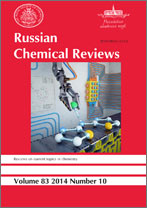|
This article is cited in 26 scientific papers (total in 26 papers)
Complexes of Molecular Nitrogen
Yu. G. Borod'ko, A. E. Shilov
Chernogolovka Institute of Chemical Physics of the USSR Academy of Sciences
Abstract:
The review deals with problems associated with the formation and structure of complexes of molecular nitrogen with transition metal compounds, metals, and other active species. Nitrogen interacts very weakly with acceptors of the type BF3 but is capable of forming more stable systems (of the type of diazo-compounds) with species having both acceptor and donor properties (CH2, CH, O).
On the surface of metals (nickel, palladium, platinum), nitrogen forms complexes with the linear configuration of the fragment M–N≡N.
A large number of stable complexes (nitrogenyls), also with a linear configuration of the M–N≡N fragment and analogous to the carbonyls and diazo-compounds, have been obtained recently with compounds of iron(ll), ruthenium(ll), osmium(ll), cobalt(l), rhodium(l), iridium(l), and nickel(0). In addition, dinitrogenyl compounds LnM(N2)2 and dinuclear complexes M–N≡N–M are known.
In nitrogenyl compounds nitrogen behaves as a π-electron acceptor ligand and therefore donor ligands stabilise the M–N2 bond in the complex and acceptor ligands weaken it.
The method of synthesis of nitrogenyl complexes, their properties, and the mechanism of their formation have been examined. The possibility of the involvement of dinuclear complexes in nitrogen fixation under mild conditions is discussed. The bibliography includes 121 references.
Citation:
Yu. G. Borod'ko, A. E. Shilov, “Complexes of Molecular Nitrogen”, Usp. Khim., 38:5 (1969), 761–796; Russian Chem. Reviews, 38:5 (1969), 355–374
Linking options:
https://www.mathnet.ru/eng/rcr2260https://doi.org/10.1070/RC1969v038n05ABEH001747 https://www.mathnet.ru/eng/rcr/v38/i5/p761
|


| Statistics & downloads: |
| Abstract page: | 134 |
|





 Contact us:
Contact us: Terms of Use
Terms of Use
 Registration to the website
Registration to the website Logotypes
Logotypes








